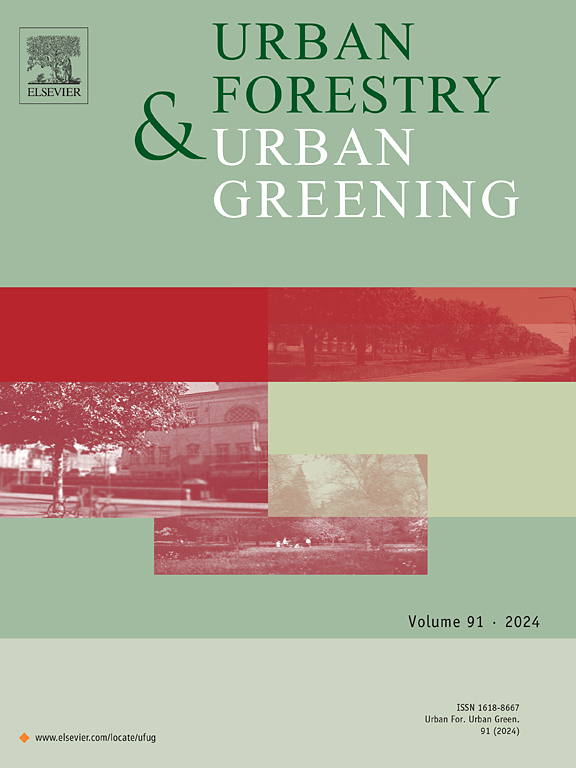研究成都口袋公园的公园属性与满意度之间的非线性关系
IF 6.7
2区 环境科学与生态学
Q1 ENVIRONMENTAL STUDIES
引用次数: 0
摘要
口袋公园已成为改善城市居民生活质量的一种流行干预措施。尽管之前的研究已经调查了公园属性如何影响用户满意度,但大多数研究都假定公园属性与用户满意度之间存在(广义的)线性关系。这种假设可能会低估与公园满意度非线性相关的停车属性的重要性,并错误估计其他属性的影响,从而对公园规划和设计产生错误的影响。在本研究中,我们采用线性回归和梯度提升决策树对成都(一个典型的大型发展中城市,目标是在 2035 年成为花园城市)的数据进行了研究,以考察公园满意度与公园属性之间的关联。两个模型都显示,公园满意度最重要的相关因素是入口位置,其次是人行道设计、乔灌木、安全、花卉、社交活动的便利性和绿化程度。此外,有些属性与公园满意度呈非线性关系。例如,绿地和花卉只有在表现良好时(即表现得分超过五级量表中的第 3 级),才会对公园满意度产生很大影响。而树木和灌木只有在表现较差时(即得分低于量表 3)才会对公园满意度产生重大影响。此外,一些看似不重要的属性(如娱乐设施和公园维护),在公园用户对这些属性极不满意时(即其表现得分处于最低水平),也会对公园满意度产生不小的负面影响。这种非线性关系为密集发展的城市地区小型公共公园的设计提供了细微的启示。本文章由计算机程序翻译,如有差异,请以英文原文为准。
Examining the nonlinear relationships between park attributes and satisfaction with pocket parks in Chengdu
Pocket parks have become a popular intervention for improving urban residents’ quality of life. Although previous studies have investigated how park attributes contribute to user satisfaction, most assume that they have a (generalized) linear relationship. The assumption may understate the importance of parking attributes that are nonlinearly associated with park satisfaction and misestimate the effects of other attributes, yielding flawed implications for park planning and design. In this study, we employed linear regression and gradient boosting decision trees sequentially on data from Chengdu, a typical large and developing city aiming to become a Garden City by 2035, to examine the associations between park satisfaction and park attributes, which were measured on a five-point scale. Both models showed that the most important correlate of park satisfaction is entrance location, followed by footpath design, trees and shrubs, safety, flowers, convenience for social activities, and greenness. Moreover, some attributes are nonlinearly related to park satisfaction. For instance, green spaces and flowers greatly contribute to park satisfaction only when they perform well (i.e., their performance scores exceed Scale 3 of the five-point scale). The attribute of trees and shrubs affects park satisfaction substantially only when its performance is inferior (i.e., its score is lower than Scale 3). Furthermore, some seemingly unimportant attributes (such as recreational facilities and park maintenance) impose a non-trivial detrimental impact on park satisfaction when park users are extremely dissatisfied with the attributes (i.e., their performance scores are at the lowest level). The nonlinear relationships offer nuanced insights on the design of small public parks in densely developed urban areas.
求助全文
通过发布文献求助,成功后即可免费获取论文全文。
去求助
来源期刊

Urban Forestry & Urban Greening
FORESTRY-
CiteScore
11.70
自引率
12.50%
发文量
289
审稿时长
70 days
期刊介绍:
Urban Forestry and Urban Greening is a refereed, international journal aimed at presenting high-quality research with urban and peri-urban woody and non-woody vegetation and its use, planning, design, establishment and management as its main topics. Urban Forestry and Urban Greening concentrates on all tree-dominated (as joint together in the urban forest) as well as other green resources in and around urban areas, such as woodlands, public and private urban parks and gardens, urban nature areas, street tree and square plantations, botanical gardens and cemeteries.
The journal welcomes basic and applied research papers, as well as review papers and short communications. Contributions should focus on one or more of the following aspects:
-Form and functions of urban forests and other vegetation, including aspects of urban ecology.
-Policy-making, planning and design related to urban forests and other vegetation.
-Selection and establishment of tree resources and other vegetation for urban environments.
-Management of urban forests and other vegetation.
Original contributions of a high academic standard are invited from a wide range of disciplines and fields, including forestry, biology, horticulture, arboriculture, landscape ecology, pathology, soil science, hydrology, landscape architecture, landscape planning, urban planning and design, economics, sociology, environmental psychology, public health, and education.
 求助内容:
求助内容: 应助结果提醒方式:
应助结果提醒方式:


